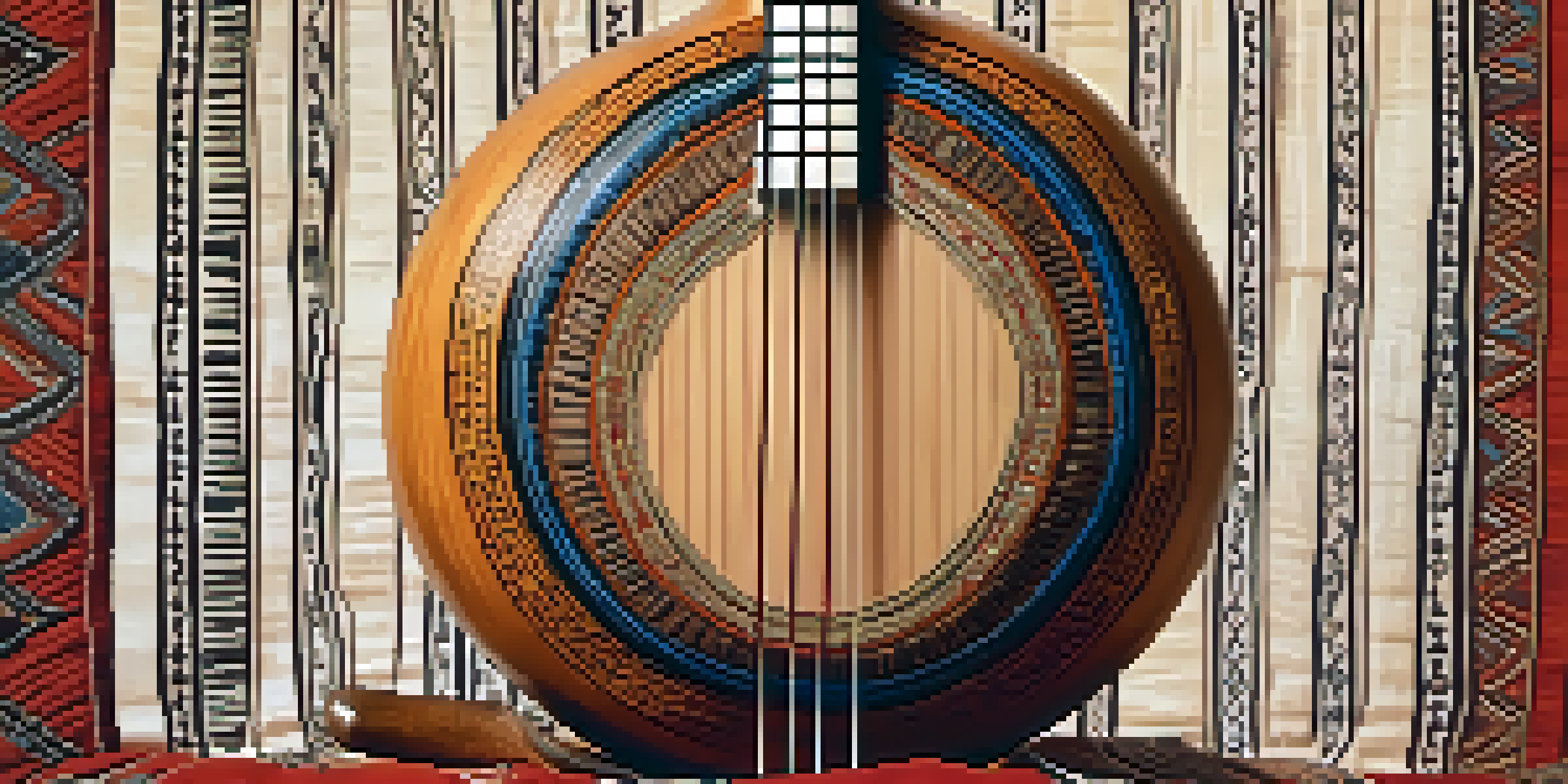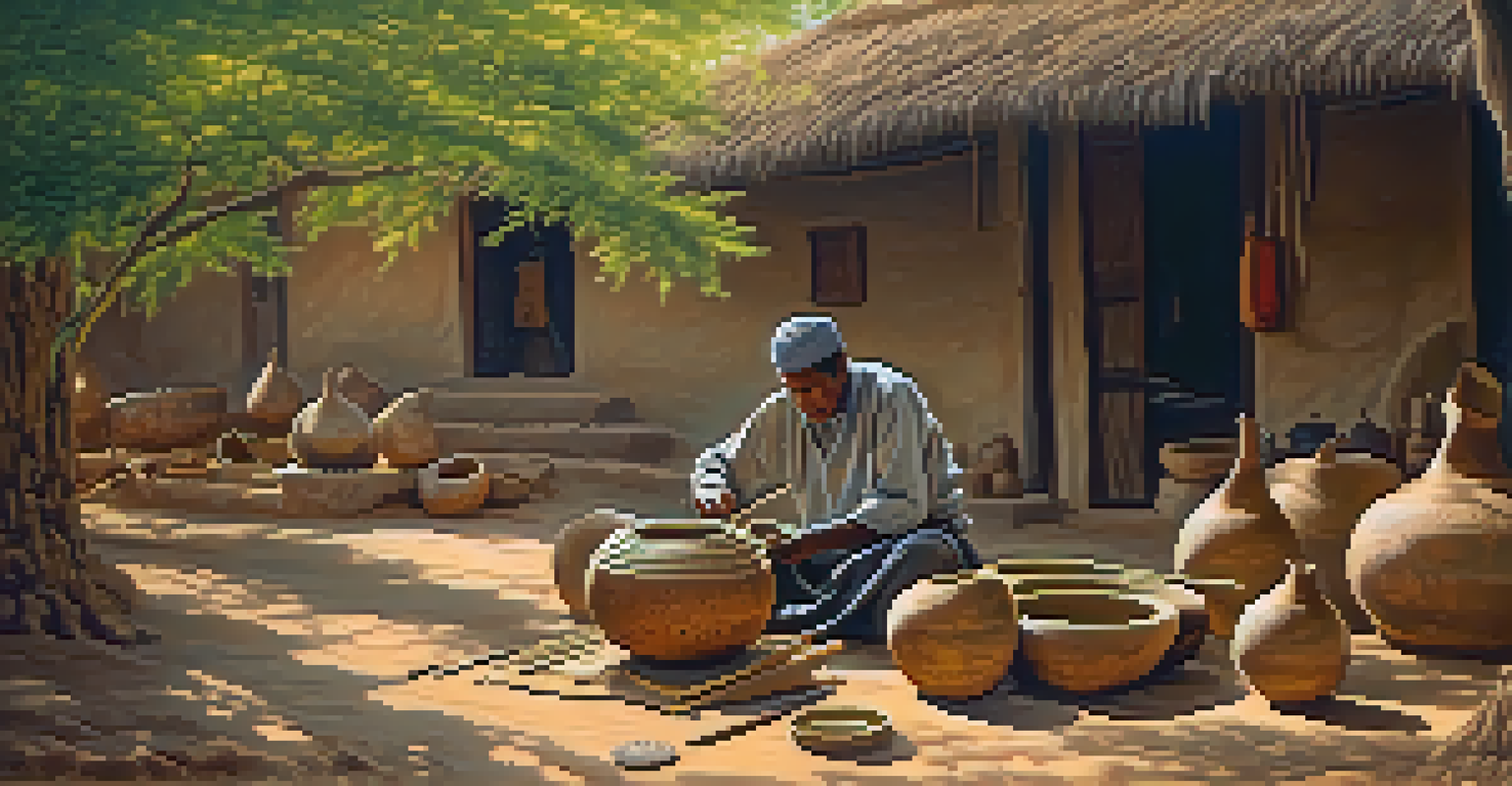The Kora: A West African Harp-Lute with Rich Traditions

Introduction to the Kora: A Unique Instrument
The Kora is a stunning stringed instrument that hails from West Africa, specifically among the Mandinka people of countries like Mali, Senegal, and Gambia. It combines features of both a harp and a lute, creating a unique sound that captivates audiences worldwide. Traditionally made from a large gourd resonator and strings crafted from either nylon or animal gut, the Kora is as beautiful to look at as it is to hear.
The Kora is a beautiful instrument that not only produces enchanting melodies but also tells the stories of the people who play it.
This instrument has been played for centuries, often accompanying storytelling, celebrations, and rituals. Its rich tones and intricate melodies reflect the deep cultural heritage of the regions where it thrives. With a history that dates back over 500 years, the Kora is not just an instrument; it's a living piece of art that tells the stories of its people.
As you delve into the world of the Kora, you'll find that its music transcends borders, inviting listeners to experience the rich tapestry of West African culture. Each note played on the Kora carries with it the weight of history, tradition, and the artistry of skilled musicians.
The Anatomy of the Kora: A Closer Look
Understanding the Kora begins with its structure. The instrument typically features 21 strings, which are stretched over a bridge that sits atop a gourd. This design allows for a resonant sound that is both powerful and delicate. The strings are played using the fingers, often in a plucking style that produces intricate melodies.

The use of natural materials, such as wood for the neck and gourd for the body, adds to the Kora's distinctive sound. Each Kora is handcrafted, meaning no two instruments are exactly alike. This individuality is part of what makes the Kora so special, as each musician's touch and style can create a unique interpretation of traditional music.
The Kora's Unique Structure
Featuring 21 strings over a gourd, the Kora produces intricate melodies that reflect its rich cultural heritage.
Additionally, the Kora's wide range allows musicians to play everything from soothing lullabies to energetic dance tunes. The versatility of the Kora makes it a favored choice for solo performances as well as ensemble music, showcasing its ability to adapt to various musical contexts.
Cultural Significance of the Kora in West Africa
The Kora is deeply intertwined with the social and cultural fabric of West Africa. It is often played by griots, who are traditional storytellers, historians, and musicians. These griots pass down oral histories and genealogies through music, using the Kora as their primary instrument. In this way, the Kora serves as a bridge between generations, preserving important cultural narratives.
Music is the universal language of mankind, and the Kora speaks volumes across cultures and generations.
Beyond storytelling, the Kora is integral to various ceremonies and celebrations, from weddings to naming ceremonies. Its music can evoke a range of emotions, from joy to reflection, making it a pivotal part of community life. When a Kora is played, it often brings people together, fostering a sense of unity and shared experience.
Moreover, the Kora's influence has spread beyond West Africa, inspiring musicians around the globe. Its unique sound has found a place in diverse music genres, blending traditional West African rhythms with contemporary styles, showcasing its adaptability and enduring appeal.
Learning to Play the Kora: A Journey of Patience
For those interested in learning the Kora, the journey can be both rewarding and challenging. Mastering this instrument requires patience and dedication, as its intricate melodies demand practice and precision. Many aspiring Kora players start by learning from experienced musicians, often through oral tradition, which emphasizes the importance of mentorship in this art form.
Beginner players typically focus on basic techniques, such as finger placement and simple melodies, before progressing to more complex pieces. As with any musical instrument, consistency in practice is key. Over time, players develop not only their technical skills but also a deeper appreciation for the rich cultural heritage that the Kora embodies.
Cultural Role of the Kora
The Kora is vital in West African culture, often played by griots to preserve stories and celebrate community events.
Additionally, learning to play the Kora can be a deeply personal journey. Many musicians find themselves connecting with their cultural roots as they explore traditional songs and styles, making it more than just a musical endeavor but a way to engage with their identity and history.
The Kora in Contemporary Music: A Global Influence
In recent years, the Kora has gained significant recognition on the global music stage. Artists across various genres have incorporated the Kora into their work, blending its traditional sound with contemporary styles. This fusion has not only introduced the instrument to new audiences but has also enriched the musical landscape, creating innovative sounds that resonate with diverse listeners.
Collaborations between Kora players and musicians from different backgrounds have led to exciting musical experiments. For example, some artists fuse Kora music with jazz, pop, and even electronic music, showcasing the instrument's versatility and ability to adapt. This blending of genres highlights the Kora's relevance in today's music scene, proving that it can transcend cultural boundaries.
As the Kora continues to evolve, it serves as a reminder of the power of music to connect people. Its journey from West Africa to international stages illustrates how traditional instruments can find new life and meaning in a modern context, inviting everyone to experience its enchanting sound.
The Craftsmanship Behind the Kora: Artisans at Work
Creating a Kora is a labor of love that involves skilled artisans who understand the intricacies of the instrument. The process begins with selecting the right materials, often involving locally sourced woods and gourds. Each step, from shaping the body to stringing the instrument, requires precision and an understanding of acoustics to ensure the Kora produces its characteristic sound.
Artisans often learn their craft through generations of family tradition, with knowledge passed down from parent to child. This apprenticeship not only preserves the techniques needed to create Kora but also reinforces the cultural significance of the instrument within the community. It's a beautiful example of how craftsmanship and art are intertwined with cultural identity.
Global Influence of the Kora
The Kora's adaptability has led to its integration into various music genres worldwide, showcasing its relevance in contemporary music.
The care and attention to detail that goes into each Kora make them unique pieces of art. Musicians often take pride in their instruments, knowing that each one has a story and a connection to the artisan who built it. This relationship between the musician and their Kora adds another layer of depth to the music created, making every performance a celebration of both artistry and tradition.
Conclusion: The Enduring Legacy of the Kora
The Kora stands as a testament to the rich musical heritage of West Africa, embodying the stories, traditions, and artistry of its people. Its unique sound, cultural significance, and adaptability have allowed it to thrive for centuries and continue to evolve in contemporary music. Whether played at traditional ceremonies or on international stages, the Kora's melodies resonate with audiences around the world.
As we explore the Kora, we not only appreciate the beauty of its music but also the deep connections it fosters among people. The instrument serves as a reminder of the power of storytelling through music, bridging gaps between cultures and generations. Each note played on the Kora weaves a narrative that speaks to the shared human experience.

In an ever-changing world, the Kora's enduring legacy invites us to celebrate our diverse cultural heritages while embracing new interpretations. As musicians continue to explore its possibilities, the Kora will undoubtedly remain a vital part of the global music landscape, captivating hearts and minds for generations to come.